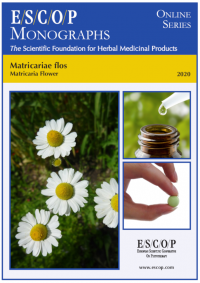
ESCOP monographs The Scientific Foundation for Herbal Medicinal Products. Online series. Matricaria flos (Matricaria flower). Exeter: ESCOP; 2020.
Matricariae flos (Matricaria flower)
Matricaria recutita L. [Chamomilla recutita (L.) Rauschert]
Published 2020
Format: PDF
>> Ver online (30¤ al año, gratis para los socios de SEFIT)
>> Descargar monografía (15¤ para el público general, para los socios de SEFIT: 12¤)
SUMMARY
The herbal monograph selects and summarises scientific studies and textbooks regarding efficacy, dosage and safety to support the therapeutic uses of matricaria flower.
This herbal drug by definition consists of the dried capitula of Matricaria recutita L. [Chamomilla recutita (L.) Rauschert].
Studies with its main characteristic constituents apigenin, apigenin-7-glucoside, flavone derivatives, (-)-α-bisabolol, trans-en-yne-dicycloethers and the essential oil are included, as are herniarin and matricin (which is converted to chamazulene on distillation of the oil).
The therapeutic indications for internal use are gastrointestinal complaints such as minor spasms, epigastric distension, flatulence and belching. For external use they are minor inflammation and irritations of skin and mucosa, including the oral cavity and the gums (mouth washes), the respiratory tract (inhalations) and the anal and genital area (baths, ointments).
Administration of matricaria flower addresses posology; its duration of use; contra-indications; special warnings; special precautions for use; interactions with other medicinal products; other forms of interaction; in pregnancy and lactation; its effects on ability to drive; undesirable effects; overdose.
In vitro experiments with matricaria flower or its constituents, demonstrated anti-inflammatory, antispasmodic, sedative and antimicrobial effects.
In vivo experiments with matricaria flower or its extracts demonstrated anti-inflammatory, anti-ulcerogenic and wound healing, as well as sedative properties.
Pharmacological studies in humans concern its anti-inflammatory activities, e.g. in chemically-induced toxic dermatitis and skin redness.
Controlled clinical studies with matricaria flower extract and preparations demonstrated its use as an antispasmodic agent, in patients with various gastrointestinal complaints; in wound healing, in patients with weeping dermatoses, following dermabrasion of tattoos and in patients with second degree haemorrhoids.
Pharmacokinetics of cutaneous or orally administered constituents of matricaria flower and an extract containing herniarin, were assessed in animals and humans. Preclinical safety data were assessed in toxicity studies. Safety data were assessed in human studies. Rare cases of contact allergy have been reported. The selection of literature cited in the monograph is aimed at bringing together relevant information about the possible physiological roles of matricaria flower and its major constituents.
KEYWORDS
- Matricariae flos
- Matricaria Flower
- Matricaria recutita L. [Chamomilla recutita (L.) Rauschert].
- Intestinal disorder: gastrointestinal complaints (including minor spasms, epigastric distension, flatulence and belching)
- Dermatological disorder: Mouth and throat disorder, minor inflammation and irritations of skin and mucosa, (including the oral cavity and the gums, the respiratory tract and the anal and genital area)
Reference: European Scientific Cooperative On Phytotherapy. ESCOP monographs The Scientific Foundation for Herbal Medicinal Products. Online series. Matricaria flos (Matricaria flower). Exeter: ESCOP; 2020.
